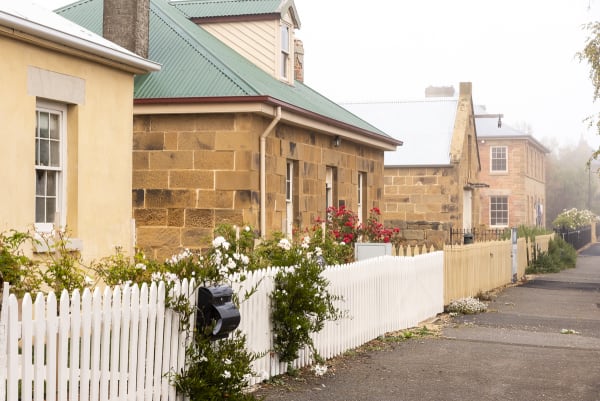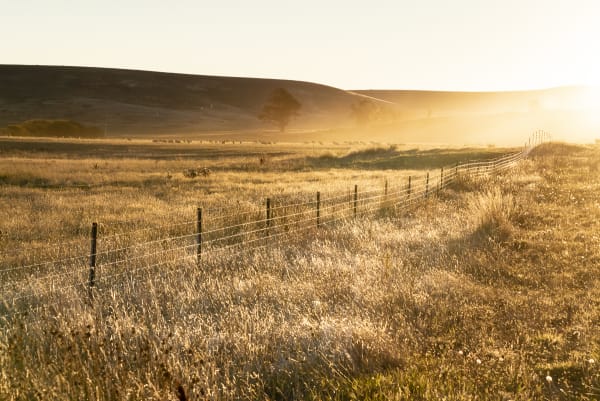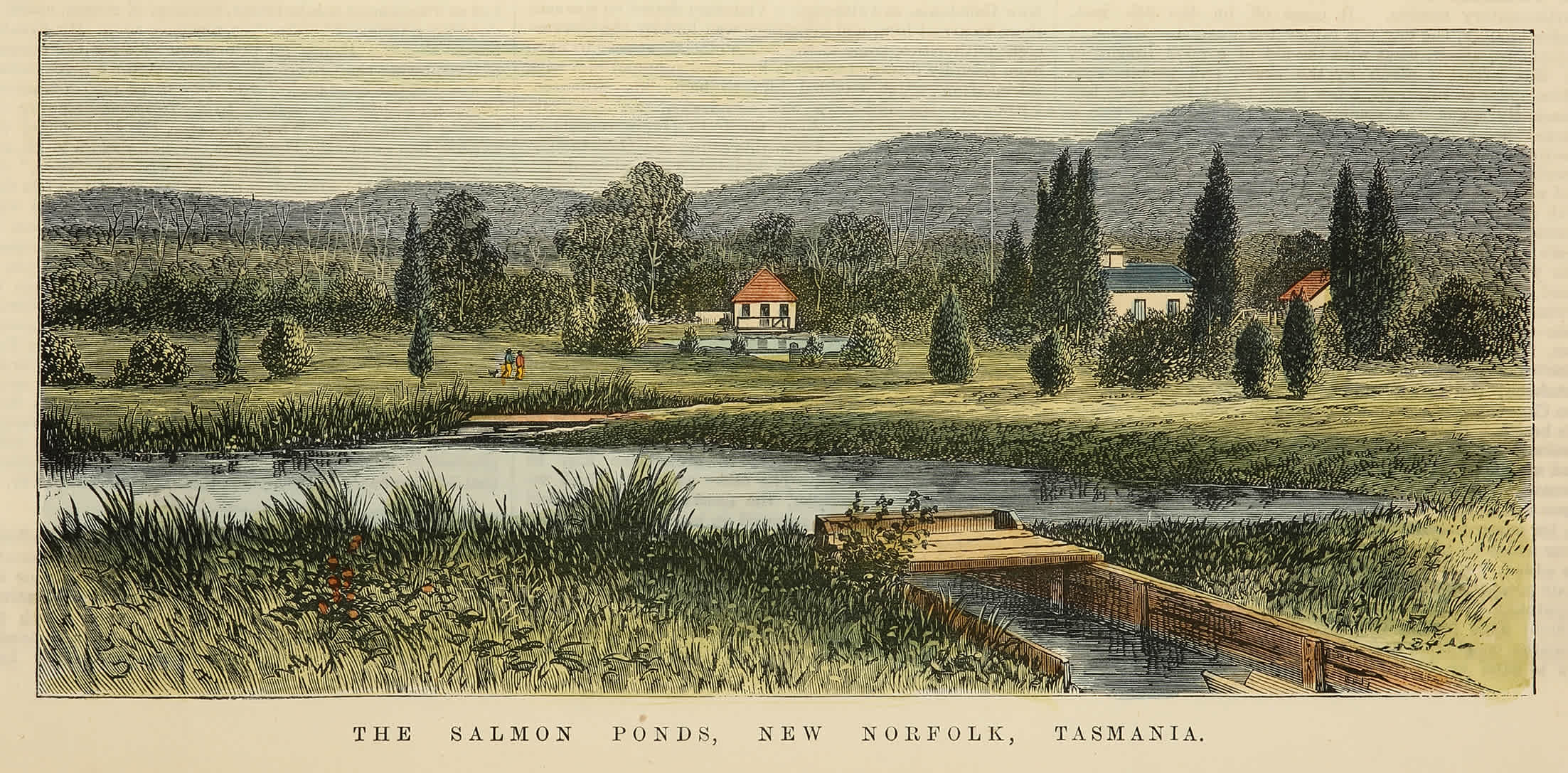

writer Bert Spinks
photographer Pen Tayler
It doesn’t take long for the subject to come up. I’m in The Imbibers, a gorgeous little bar on the main drag of Oatlands, eagerly eavesdropping on some tourists enjoying a gin tasting. “So,” a middle-aged woman asks the barman, “do you have any ghost stories?”
There’s something about these old Tasmanian towns that makes many of us suspect they’re haunted. I feel it particularly in the Midlands, a sense that something in history has gone unquenched here. The land often appears empty, but we know many stories have passed through this region. And perhaps Oatlands prompts the thought of ghosts more than anywhere. With a significant percentage of original sandstone buildings – including penal and military structures – the town’s recent past is close to the surface.
Ghost stories! Perhaps I’m lurching into a Tasmanian cliché here, but I’ve found it hard to avoid. On my most recent visit to Oatlands, I was introduced to Peter, a local historian who let me tag along on a ghost tour he was guiding. It was 10am on a gloomy sort of day, with southerly gusts raking the Midlands, and it was a relief to duck into the old colonial supreme court and gaol. But I had never been on a ghost tour in the broad daylight. When the sun’s out, most of the romance and theatre is lost. Instead, you find yourself with the brutal facts of those bygone days.
Peter can certainly spin a yarn. In an engaging and idiosyncratic manner, he hinted that he could see how history kept recurring through the present moment. The systems of today have perhaps not evolved as much as we’d like to think. As he unlocked the old commissariat building (which was constructed in 1828), Peter told a yarn about the escaped bushranger Martin Cash, who was “running amok” not far away. The commissariat was a military building, and had a cache of weapons in there – but when soldiers came to unlock the store, it turned out no-one knew the whereabouts of the building’s key. “Now doesn’t that just sound like something a government might do these days?”


Oatlands was named by Lachlan Macquarie, who strode purposefully through the Midlands in both 1811 and 1821. This spot was quickly identified as a “very eligible situation for a town”. It had reliable water and a surfeit of sandstone.
For a while it was just a wooden sign in a clearing, but by the end of the 1820s farmland had stretched out in all directions. The land was granted to free settlers or those who had finished their transportation sentence, but mostly co-ordinated by convict labourers. It was a precarious system and a tumultuous time in the island’s history. The early tales of Oatlands seem to be drawn from every demographic. Even the government hangman, Solomon Blay, lived in Oatlands; local lore suggests that his hut was where the bowls club now stands.
Macquarie’s toponyms dot the Midlands, marking the well-used highway between Launceston and Hobart. Familiarity can indeed breed contempt, and locals often speak scornfully of this thoroughfare. I enjoy the journey. The landscape’s contours are beautiful, and the colours change throughout the year. Where roadworks effect a pause in the journey, I like to take it as a chance to contemplate a section of the landscape I’m usually passing at 110km/h. And a surprise snow-dump one August was a fine reminder that we can never get too familiar with Tasmanian towns – Oatlands was blanketed with white, a winter makeover. Startled motorists were forced to detour into town (or abandon their cars at Spring Hill) as the roads became unsafe.
The enforced stop may have been inconvenient, but you ought to have a short break somewhere on the Midland Highway. Mainlanders may be able to zoom through a couple hours without taking a breather, but Tasmanian tradition suggests we do things otherwise. In recent times Oatlands has become my preferred stopover. It’s not all ghosts; Oatlands has a living population of around 700 people. When I recently popped in for a coffee stop, there was a small community group vehemently speaking about the results of a raffle.
Alongside such kerfuffles, locals are having plenty of robust debate about how to move into the future. You can sense an optimistic mood in Oatlands at the moment, but somewhat cautious about what lies ahead. Prompting the most discussion is the development taking place at Callington Mill, built in 1836. Its recent revival as a functioning mill was short-lived, but a Sydney investor has commissioned a distillery. Now the local council is calling for a proponent to run a boutique hotel in town. Now Oatlands is facing a situation that many Tassie towns have to wrestle with – trying to make the most of being in demand, while maintaining the best characteristics of their community.
If ever there was a time to explore how the past and future meet, it may as well be now – 2021 is the bicentenary of the naming of Oatlands. The early Tasmanian travel writer E.T. Emmett – whose 1952 book Tasmania By Road and Track somewhat prefigures this present collection – dreamed up how the occasion might look. He wanted Callington Mill (which was defunct at that time) operating “to grind fresh coffee for the evening supper”, and proposed a sort of pageant or play in the courtyard of the old gaol, featuring characters from the past. Something of this nature was created in early June, although that day’s dreadful weather may have kept away some of those who would have dressed up in the attire Emmett suggested, such as “the cricket team in top hats”.
The parade will wander past some of the good examples of how the present co-exists with the colonial past. The Imbibers is a good example: the proprietors have converted a small and storied shopfront into an elegant drinking establishment, replete with all the best Tassie gourmet grog, cheese and coffee. The town has a thoroughly enjoyable antiques shop, once the old General Store; the charming Weaver’s Cottages Studio (selling beautiful knitwear, among other crafty creations) is fittingly in the former home of a Luddite convict. At the more cosmopolitan Jardin Room, which sources antiques and interior décor from around the world, I eyed a “19th-century Austro-Hungarian folk painted trunk”. It was slightly beyond my price range; I ended up buying a schoolbag from the op-shop down the road).


It’s not a big town, but those with even the vaguest interest in architecture will be more than satisfied. Buildings designed by the likes of Augustus Pugin and John Lee Archer are present, but really, there are countless treasures in Oatlands. Every surface seems to be made of sandstone, which, like the landscape around it, has such subtle variations in shade, and interacts with the changes in light. It gives the town a series of exquisite textures – so much so that someone recently told me that they’d like to go on a feeling tour of Oatlands, enjoying the buildings by touch alone.
Are there really ghosts behind those walls? At the very least there are the knotty old stories, the ones that aren’t yet well-told and so seem to spring up and catch us unawares. The references to convict history remind us of the injustices of penal history, the ugliness of the suffering of exiles. But further reflection, of course, takes us into even more uncomfortable territory.
The commissariat was also used a base for the Black Line, which passed through here in 1829. This enormous operation, conducted under the authority of Lieutenant-Governor Arthur, has gone down in notoriety, but it was only one chapter of the vicious colonial story. In our histories, we hear almost exclusively from colonists. But even within this limitation we can catch a glimpse of what it meant for Aboriginal Tasmanians to experience the loss of their homeland.
The missionary George Robinson came by here in 1831, with Aboriginal companions. A few miles south of Oatlands, they crossed the new road – the original version of the Midland Highway. In his journal, Robinson reports that one Aboriginal leader “viewed with much surprise the fragments of stones which had been broken to metal the road”. His surprise was no doubt mingled with concern, to assume the least. Robinson continued, oblivious, “Saw some beautiful farms as we passed and numerous white people ...”
Colonial settlement was clearly gathering speed, uprooting the traditional lifestyles.
The poet in me wants to suggest that a ghost is just an unresolved story. Slowly, I believe, Midlands landowners are opening to the difficult legacy of colonialism. But it’s a tangled tale that will follow us into the future. Entwined with the impact on human history are environmental changes; the effects of different land use were noted around Oatlands as early as the 1820s. The changing climate, of course, causes challenges today, and with the Midlands enduring unpredictable rainfalls, threatening both agriculture and native flora, it strikes me that our actions now will shape the kind of story we look back upon later.


The barman at The Imbibers gave a rather charming answer to the tourist’s question about ghosts. “Oh, you know,” he said, “sometimes when I’m alone in here, I sense something at my peripheries. But it doesn’t bother me. They were here first.”
It’s with that in mind I find myself wandering thoughtfully along the shores of Lake Dulverton, which forms a refuge for birdlife in the midst of the mostly-cleared farmland around it. My walk takes me – as if inevitably – to the old general cemetery. I read the names and dates, although I have to squint to interpret some of the lichen-encrusted epitaphs. It’s not there amidst the other memorial verses, but I think of some lines from Rainer Maria Rilke:
Don’t be ashamed when the dead brush against you,
exchange glances peacefully with them…
Some rosellas play on another stiff gust, streaking away to a eucalyptus stag in the distance, and I find myself wondering what it will take to deal with the shame we do feel when we encounter our island’s ghosts. Anniversary celebrations and dress-up parades won’t suffice. It’ll take honesty and openness, a scrutiny of the full human history of these places, in the clear, raw light of day.
This article provides a first glimpse into Forty South Publishing's latest project, Volume II of Towns of Tasmania. Storyteller Bert Spinks has sharpened his quills and Pen Tayler is crawling out of bed at shockingly early hours to find the dawn light and winter mists through which she so likes to photograph Tasmania. While the second volume is on its way, find a copy of the first Towns of Tasmania: A Journey Through Time via the Forty South online bookshop.








